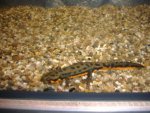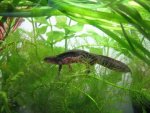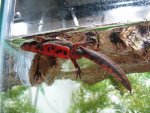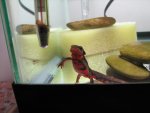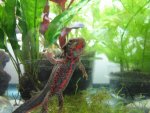WilliamBlake
New member
- Joined
- Apr 21, 2010
- Messages
- 26
- Reaction score
- 0
- Points
- 0
- Country
- France
Hey all,
I'd really like to find one female for my 2 "gay" guys, the problem is, no one can find for sure from which pyrrho subspecie they belong.
They live in a tank with 3 Sasayamae (2 males one female), the Sasayamae female doesn't seem to interest their mating behavior.
They are quite smaller than my pyrrhos, have a smoother skin, and have a more aquatic behavior.
They clearly have a narrow-ended tail (you know, a (long)filament ended tail -excuse me i don't know the word in english) - you'll see the end of the tail on the pictures (the bigger male has a narrow ended tail too now, but when i took the pictures he wasn't mating so it seems less obvious).
Obviously they are 2 males from the same pyrrho subspecie, but strange fact one is much smaller than the other (the bigger one is tosay in "mating" dress so his cloaca is enormous, and his tail is filament-narrow ended. The bigger one is +/- as big as my other male Sasayamae, but the small one is as big as, say, a big female orientalis.
The smaller one is always very "horny" (excuse my approximative words i'm french) and he always tries to seduce the other male, but almost never tries to seduce my sasayamae female.
The bigger one ignores him, so when the smaller is too excited he bites the bigger one's side or tail.
According to those elements, i can almost exclude all the known pyrrhogaster subspecies...
So here are the pictures, maybe you guys can help me find their ID so i have more chance to find them a girl and stop this much immoral homosexual behavior (this is humor





I'd really like to find one female for my 2 "gay" guys, the problem is, no one can find for sure from which pyrrho subspecie they belong.
They live in a tank with 3 Sasayamae (2 males one female), the Sasayamae female doesn't seem to interest their mating behavior.
They are quite smaller than my pyrrhos, have a smoother skin, and have a more aquatic behavior.
They clearly have a narrow-ended tail (you know, a (long)filament ended tail -excuse me i don't know the word in english) - you'll see the end of the tail on the pictures (the bigger male has a narrow ended tail too now, but when i took the pictures he wasn't mating so it seems less obvious).
Obviously they are 2 males from the same pyrrho subspecie, but strange fact one is much smaller than the other (the bigger one is tosay in "mating" dress so his cloaca is enormous, and his tail is filament-narrow ended. The bigger one is +/- as big as my other male Sasayamae, but the small one is as big as, say, a big female orientalis.
The smaller one is always very "horny" (excuse my approximative words i'm french) and he always tries to seduce the other male, but almost never tries to seduce my sasayamae female.
The bigger one ignores him, so when the smaller is too excited he bites the bigger one's side or tail.
According to those elements, i can almost exclude all the known pyrrhogaster subspecies...
So here are the pictures, maybe you guys can help me find their ID so i have more chance to find them a girl and stop this much immoral homosexual behavior (this is humor






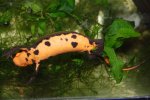
![pyrrhogaster Kanagawa 3 [640x480].JPG](/data/attachments/12/12285-37e3dcd498ee122b6af65241514bc4cf.jpg)
